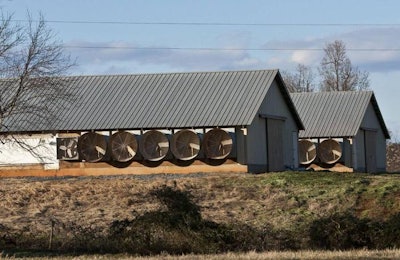
Modern broilers convert 35 percent of the feed energy they consume into useful functions like growth, locomotion and maintenance. The other 65 percent of the energy is converted to waste heat, which is useful for maintaining warm temperatures in the poultry house in the winter, but presents a challenge in the summer months.
Mike Czarick, extension specialist, agricultural engineering, University of Georgia, said, “A 6.0-pound broiler produces around 90 British thermal units (BTUs) of heat per hour. This is the same amount of heat produced by 90 matches. A broiler house with 23,000 7.5-pound birds is generating 3 million BTUs of heat per hour.” He told the audience of WATT Global Media’s first poultry grower webinar, Broiler house nighttime ventilation & LED Lighting, sponsored by Choretime Inc., that this flock of 23,000 7.5-pound broilers produces as much heat in an hour as is contained in 32 gallons of gasoline.
Just as an automobile engine, which only converts about 25 percent of the energy in the gasoline it burns into mechanical energy, needs a radiator to get rid of waste heat, birds need to get rid of the heat generated by digestion and physical activity.
Birds basically lose heat in two ways. The first is to lose heat from the surface of its body to the surrounding air. The amount of heat lost is then dependent on the temperature differential between the bird’s body, which is around 106 F, and the surrounding air. The second means of losing heat is through evaporation off of the bird’s respiratory system; birds don’t sweat like people do. Birds lose around 65 percent of the heat they generate through evaporation off the respiratory system and around 35 percent through convection to the surrounding air.
“Birds are extremely sensitive to humidity,” said Czarick. He explained that air temperature is an important factor in heat loss for birds, but that the relative humidity of the air is even more important. Birds generate heat 24 hours a day. During hot weather it is always difficult to remove all that heat during the daytime. The warmer the air gets, the less heat the bird loses to the air.
The higher the temperatures in the house, then the less heat is removed by each cubic foot of air, then the greater the number of cubic feet of air we need to move over the bird. Czarick explained that even in the best houses, bird body temperature will tend to increase during the day when birds get bigger and outside temperatures are warm. “As bird body temperature increases, feed consumption will decrease and bird performance will drop as well,” he said.
In the evening as house temperatures decrease, heat removal increases, but we need to keep moving air at high velocities to make sure this happens. One confounding factor is that as house temperatures fall in the night, the relative humidity increases, which means birds aren’t losing as much temperature from breathing.
When temperature is below 80 F at night, relative humidity is usually over 80 percent and that can be stressful for the birds. Czarick said that if airspeeds aren’t maintained over 500 feet per minute at night, birds can get heat stressed. During the summertime, birds the best performance will come in flocks that run maximum air velocity 24 hours per day during the last two or three weeks of the flock.
Learn about how your lighting program can impact heat production in the broiler house by watching the webinar.
Looking for more? View these videos Managing the heat generated by poultry in your barns and Factors to consider in poultry house lighting decisions


















